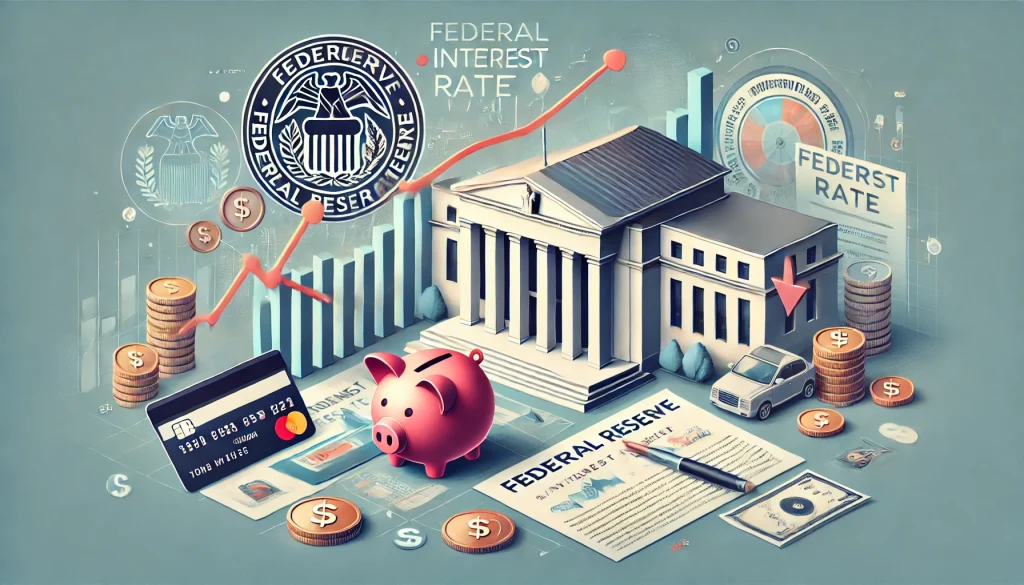The role of the Federal Reserve in shaping economic landscapes is pivotal, with its decisions on interest rates directly affecting both consumers and investors alike. Federal Reserve interest rate changes can shift the dynamics of borrowing, savings, and investment across the nation. Understanding why and how these changes occur—and their widespread implications—is crucial for effective financial planning.
The decisions taken by the Federal Reserve on interest rates are more than mere adjustments; they are strategic moves to balance economic dynamics. By altering rates, the Fed can either stimulate economic growth by making borrowing cheaper or control inflation by making it more expensive. These shifts impact everything from mortgage rates to the returns on savings accounts, influencing everyday financial decisions.
Why Federal Reserve interest rate changes are crucial

The Federal Reserve, as the central bank of the United States, plays a fundamental role in managing the country’s monetary policy. Its decisions on interest rates are designed to maintain economic stability and control inflation.
Consumers and investors feel the ripple effects of these decisions in various ways. For instance, lower rates might encourage spending and investment while high rates can lead to increased savings and reduced borrowing.
Being aware of Federal Reserve interest rate changes provides critical insights into economic trends. It allows individuals to align their financial strategies with prevailing economic conditions. Whether it’s benefiting from lower rates or preparing for potential hikes, staying informed helps in making sound financial choices that optimize outcomes in changing markets.
How Federal Reserve interest rate changes work
Federal Reserve interest rate changes are driven by several factors, primarily inflation and economic growth. When inflation is high, and the economy is growing rapidly, the Fed might increase rates to keep inflation in check.
This relationship between economic indicators and interest rates forms the core of the Fed’s monetary policies. By understanding these patterns, consumers and investors can better anticipate future rate changes and adjust their financial plans accordingly, safeguarding themselves against unfavorable economic shifts.
The Fed’s decisions are influenced by comprehensive data analysis and economic modeling. Understanding these variables underscores the complex nature of rate adjustments. It emphasizes why individuals and businesses must pay attention to Federal Reserve announcements and adapt their financial practices in response to these changes.
Impact on borrowing costs: loans, mortgages, and credit cards
Federal Reserve interest rate changes have a direct impact on borrowing costs, affecting personal loans, mortgages, and credit card rates. When the Fed raises rates, borrowing becomes more expensive, which can increase monthly payments on existing variable-rate loans and new loans.
This rise in borrowing costs necessitates careful financial planning and debt management. Consumers may need to explore refinancing options or alter spending habits to adapt to the new financial landscape. Conversely, when rates decrease, borrowers can benefit from lower financing costs and potentially save on interest payments over the life of their loans.
Understanding the relationship between federal interest rates and loan costs is crucial for individuals managing personal debt. It helps in making strategic decisions about repayments and future borrowing. Prudent financial management, in light of rate changes, can prevent over-leveraging and ensure sustainable financial health over time.
Savings and investment returns: winners and losers
Changes in Federal Reserve interest rates significantly affect savings accounts, Certificates of Deposit (CDs), and government bonds, areas that generally benefit from higher rates. As interest rates rise, so do the yields on these instruments, offering better returns for savers.
However, higher rates can have adverse effects on stocks and fixed-income markets, as they potentially lead to diminished corporate profits and bond prices. Investors need to strategically assess their portfolios, managing risk by balancing growth-oriented investments with stable income-generating assets to navigate these fluctuations effectively.
Savvy investors will diversify their holdings to protect against adverse rate impacts, while capitalizing on opportunities as they arise from these economic adjustments. This involves reassessing asset allocation and considering investments in sectors that traditionally perform well under varied rate environments.
Effects on inflation and cost of living
Interest rate changes by the Federal Reserve are instrumental in influencing inflation and overall cost of living. Higher rates tend to slow down inflation by reducing consumer spending and borrowing, keeping price levels in check. This relationship is vital for maintaining economic stability.
As the cost of living adjusts to these changes, individuals must make corresponding adjustments to their budgets. Understanding the effect of rates on everyday expenses such as housing, food, and transportation is key to financial resilience.
How to prepare for interest rate changes
Successfully navigating Fed interest rate changes requires a proactive approach. For consumers, this includes securing fixed-rate financing options before rates increase or exploring higher-yield savings products when rates rise.
Investors can benefit by regularly reviewing and adjusting their portfolios in alignment with interest rate trends. This may involve reallocating funds towards sectors that thrive in the current rate environment or exploiting opportunities presented by emerging market conditions.
Moreover, maintaining a flexible financial strategy is essential. This flexibility ensures resilience against rate-induced financial pressures and enables strategic exploitation of beneficial rate shifts. Regular financial reviews and ongoing education about economic trends are critical steps in preparing for and capitalizing on Fed rate changes. For more insights on personal finance and financial strategies, visit Benefício Já and stay informed about the best ways to navigate economic shifts.
